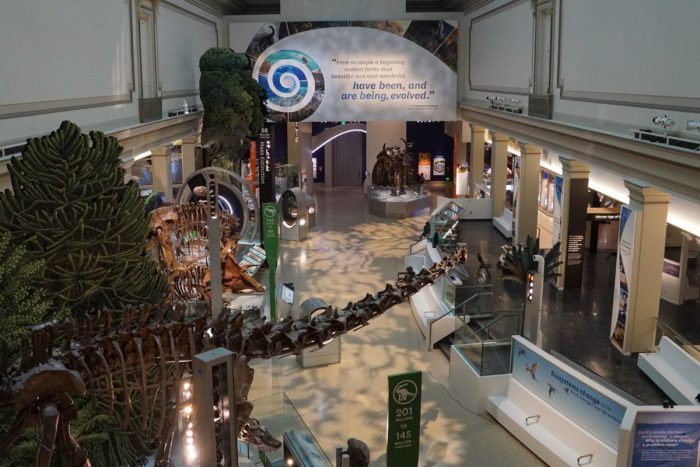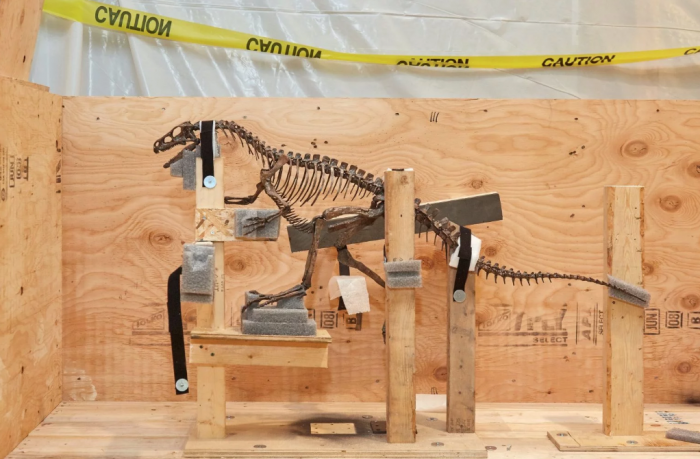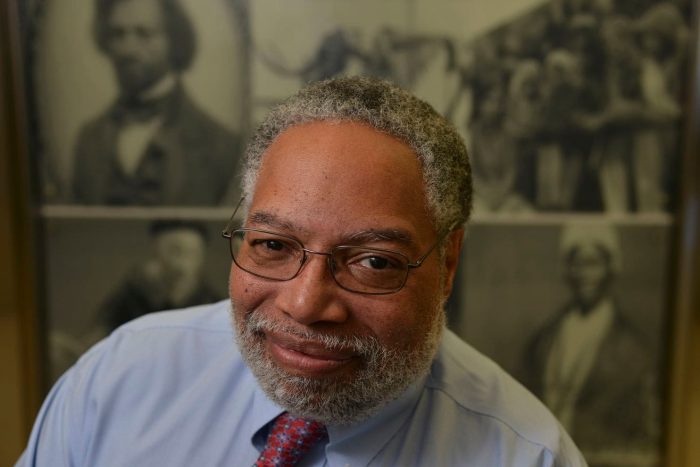ICYMI: Highlights from the week that was June 2 – June 8, 2019
No one can keep up with everything, so let us do it for you. We’ll gather the top Smithsonian stories from across the country and around the world each week so you’ll never be at a loss for conversation around the water cooler.
We’re mighty proud this week: Proud of our new Secretary, proud of our old dinosaurs and proud of, well, Pride!

The Scene: A countdown to Pride Month at the Smithsonian American Art Museum
The Washington Post, June 2

The Smithsonian American Art Museum was lit with rainbows for the event.
Chinatown got a lot brighter on Friday as nearly 1,500 attendees descended on the Smithsonian American Art Museum to celebrate the Countdown! kickoff party for Pride Month, a celebration of the LGTBQ community. Hosted by Brightest Young Things and Capital Pride, the rainbow-lit reverie featured belle of the ball Aquaria, the Season 10 winner of “RuPaul’s Drag Race” and red-carpet star of last month’s Met Gala camp-style extravaganza. Local community heroes House of Sonique, Ruth Allen Ginsburg and more performed. When the clock struck midnight, the massive crowd chanted, “Happy Queer New Year’s.” Read more from The Washington Post.
Dinosaurs are back with a climate change warning at the Smithsonian
PBS NewsHour, May 31

One hundred and eight years is just a blink of an eye for ancient bones and rocks. Yet since the Hall of Fossils first opened at the Smithsonian National Museum of Natural History in 1911, humans have fought two world wars, developed a global economy and entered the digital age. We’ve also forced changes to the planet at a speed previously only witnessed through “Deep Time,” the millions and billions of years that define how Earth evolved.
Just a century of relentless carbon emissions and dramatic shifts in resource use have lead to the extinction of hundreds of vertebrate species and other profound changes that parallel prehistoric upheavals. The time had come for a fossil hall update. Read more from PBS NewsHour.
‘The Nation’s T. rex’: How a Montana family’s hike led to an incredible discovery
The Washington Post, June 1
For five years, The Washington Post’s Lee Powell has documented the journey of a nearly complete T. rex skeleton. This is the story of “the nation’s T. rex.” (Lee Powell/The Washington Post)
A long time ago, in a part of this state that is now arid desert but was then humid swampland, an egg hatched. It was the beginning of an epoch-spanning life story that continues still, beginning a new chapter this week in the nation’s capital.
The egg is long gone. The skin and muscle of the animal that climbed out of it — 38 feet long and six tons once it grew — are history (or prehistory). But when it died on the banks of a creek after 18 good years at the top of the food chain, its bones settled into the enveloping mud. The current teased away the flesh, pushed its skull a few feet downstream, shifted a shoulder blade. Read more from The Washington Post.
The Surprising Ways Art Has Advanced Astronomy
Time, June 4
In January 2004, NASA announced it was canceling a mission to service the Hubble Space Telescope. In light of dangers associated with the Columbia tragedy the previous year, it was considered too risky. As a result, the Hubble, lauded as one of the most influential scientific instruments of all time, would have only a few remaining years to survive.
Over the following months, the plan was intensely debated. Petitions garnered thousands of signatures from members of the public. Congressional committee meetings and hearings were held. Citizens and scientists alike, inspired by the discoveries and images the telescope had produced, clearly weren’t ready for the telescope’s premature retirement. Read more from Time.
Repairing a Broken Planet Through Optimism and Design
Could you empathize better with a blade of grass if it had an email address? What about the entire ecosystem?
Hyperallergic, June 4

Antón García-Abril and Débora Mesa, Ensamble Studio, “Petrified River” (2018–19) in the garden of Cooper-Hewitt (photo by Zachary Small)
Linda Tegg wants you to empathize better with nature. She’s thought about assigning email addresses to every blade of grass in her home city of Melbourne. Why not? Trees in the Australian city already have unique ID numbers and email addresses for reporting problems like dangerous branches or vandalism. Tegg, a photographer and filmmaker, learned that people were using these email addresses to write directly to the trees themselves: love letters, existential questions. Read more from Hyperallergic
The ‘Great Dying’ Nearly Erased Life on Earth. Scientists See Similarities to Today.
NPR, June 4
The Magic Behind What You’ll See at the Smithsonian’s New Fossil Hall
Washingtonian, June 5

An eoraptor from the Triassic period, one of the earliest known dinosaurs. (Photo by Jeff Elkins for Washingtonian)
After a five-year, $110-million renovation, the beloved Fossil Hall at the National Museum of Natural History reopens this month, with more scientifically accurate exhibits and a dramatic return for our T. rex. A behind-the-scenes look at the painstaking prep that went into the largest overhaul in the museum’s history. Read more from Washingtonian.
Never-Before-Seen D-Day Footage to Premiere on National Geographic and Smithsonian Channel
Radio.com, June 5

Both the Smithsonian Channel and National Geographic are premiering special content in recognition of the 75th anniversary of D-Day — and some of it, we’ve never seen before.
The Smithsonian Channel’s documentary “The Battle of Normandy: 85 Days in Hell” premieres Thursday, June 6 at 8 p.m. ET/PT to commemorate the 75th anniversary. Dominique Forget, a Normandy native and one of the world’s most foremost experts on World War II, identified over 100 hours of previously unseen archival footage, including 20 hours of footage from the battle itself.
But the battle on the beaches of Normandy on June 6, 1944, was just the beginning. The struggle to win Normandy went on for 85 days. Co-writer and co-producer Forget meticulously pieced together the story of these 85 days.Read more from Radio.com
Smithsonian’s new secretary, Lonnie Bunch III, faces political and financial challenges
The Washington Post, May 28

Lonnie G. Bunch III, director of the National Museum of African American History and Culture, will become the next secretary of the Smithsonian. (Jahi Chikwendiu/The Washington Post)
Lonnie G. Bunch III — the founding director of the Smithsonian’s National Museum of African American History and Culture — has been appointed secretary of the Smithsonian Institution, becoming the first African American leader in its 173-year history.
The Smithsonian’s Board of Regents introduced Bunch as the institution’s 14th secretary on Tuesday morning. He succeeds David J. Skorton, who announced his resignation in December and whose last day is June 15.
Bunch, 66, takes over a quasi-federal institution of 19 museums, nine research centers and the National Zoo that is supported by 7,000 employees and a $1.5 billion annual budget. Read more from the Washington Post.
The Hirshhorn Museum’s sculpture garden is moving closer to a full overhaul –
Washington Business Journal, June 7
Cooper Hewitt’s Nature Triennial Balances Speculative Experimentation with Industry Application
Scouring the globe for recent projects, Nature taps into a new level of environmental awareness among designers, researchers, institutions, and blue-chip companies.
Metropolis, June 6

Curiosity Cloud by Austrian design duo mischer’traxler celebrates biodiversity while inviting visitors to meditate on nature’s fragility. The installation is composed of glass bulbs, each containing a handmade insect species that is native to New York. When visitors walk through the installation, the artificial insects flutter. “Entering the exhibition, visitors are immersed in this work and are immediately confronted with the idea that they are experiencing nature within a building,” deputy curatorial director Matilda McQuaid says. Courtesy Cooper Hewitt, Smithsonian Design Museum
Two recent United Nations reports have painted a bleak picture for the future of the planet. One determines that humanity has less than 12 years to drastically counteract the most catastrophic effects of climate change. The other states that millions of animal and plant species are on the verge of extinction. Together, they come as an urgent call to action that transcends government policies, consumer culture, urbanism, and industrial design. This wake-up call is adding fuel to the fire of a growing design movement—one highlighted at Nature—Cooper Hewitt Design Triennial—that’s seeking new ways to rehabilitate humanity’s relationship with nature. Read more from Metropolis.
Posted: 9 June 2019






